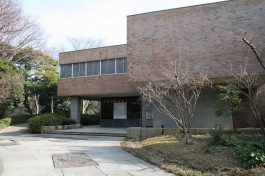Hamamatsu Municipal Museum of Art
[Route]

| Zip | 430-0947 |
|---|---|
| Address | 100-1 Matsushiro-cho, Naka-ku, Hamamatsu-shi |
| Tel | 053-454-6801 |
| Fax | 053-454-6829 |
| URL | http://www.city.hamamatsu.shizuoka.jp/artmuse/index.htm |
| Hours | 9:30am-5:00pm |
| Admission | General Exhibition/ Adults: 300 yen High School Students: 150 yen Free for over 69 and Physically Challenged People |
| Close | Mondays (except holiday Mondays) Days after holiday Mondays New Year's Holidays Exhibition Replacement Period |
Establishment
Hamamatsu Municipal Museum of Art, or Hamamatsushi Bijyutsukan, was established as the first public art museum in Shizuoka Prefecture in July 1971 at Hamamatsu Castle Park. It was a part of the celebration of the city's 60th anniversary. The museum is well known for its reddish brown-colored brick building which blends beautifully into the surrounding nature. Alongside of General Exhibition, special exhibitions are held four to five times a year.
Contents
The museum is known as a museum of glass paintings among art lovers. It houses 400 pieces of traditional and ethical glass paintings from 18th to 19th century, which are mainly from the collection Uchida. Visitors can genealogically trace the history of the West, China, and Japan through these paintings. It also contains more than 300 art pieces including Chinese and Korean ceramics and Buddha statues (Buddharupa), and 300 Ukiyo-e paintings related to the region by Hiroshige, Hokusai, the Utagawa family, and more. In addition, the museum preserves mordern Japanese paintings and 670 pieces of modern print arts by artists from Shizuoka Prefecture such as Kitagawa Minji and Akino Fuku. *No permanent exhibition.
Remarks
The glass paintings collection of the museum is largely based on the collection of Uchida Rokuro. He was an obstetrician and gynecologist in Tamachi who led the Japanese Folk Art Movement in Hamamatsu with the inspiration by the encounter with Yanagi Sōetsu, an advocate of the movement, in 1927. Based on studies of his collection, he published “Garasue”, a guide on glass paintings, in 1942. After WWII, he gave great effort on founding the museum as well as taking part in medical and social activities.